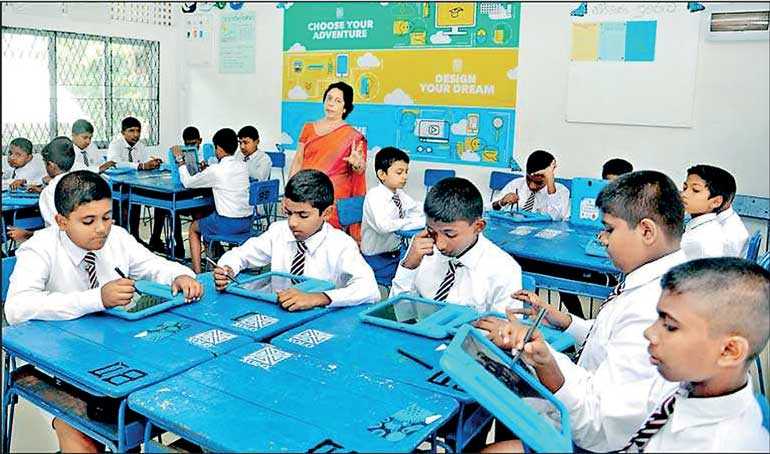Tuesday Apr 15, 2025
Tuesday Apr 15, 2025
Friday, 1 March 2019 00:00 - - {{hitsCtrl.values.hits}}

The Budget of the Government of Sri Lanka for 2017 included a line item for Rs. 5 billion to provide free tabs for  students who enter the Advanced Level (A/L) classes in public schools. It was a long overdue allocation of funds to fulfil a campaign promise made by the UNP in 2015. Unfortunately, the issue has become a political football while initial costs are escalating. Poor articulation of the initiative is to blame, I believe.
students who enter the Advanced Level (A/L) classes in public schools. It was a long overdue allocation of funds to fulfil a campaign promise made by the UNP in 2015. Unfortunately, the issue has become a political football while initial costs are escalating. Poor articulation of the initiative is to blame, I believe.
Once the politicians layout the vision, it is the responsibility of bureaucrats to articulate the vision as a convincing proposal. Such a proposal should inform the Cabinet and the public as to what learning outcomes are expected. Besides the cost of devices what other support systems are needed? How would we know the success of investment? It is not rocket science. It is essentially how one would write a good policy proposal.
So far we have heard nothing but details of a questionable procurement process. Once procured, what would the students or the teachers do with a shiny new tab in each student’s hand? How would that device translate into learning outcomes? A map of such a process is what we call a ‘theory of change’, a tool used in public policy design. Procurement specifications should match the intended mode of use. Since the bureaucrats have not done their homework, this column is an attempt to inform the Cabinet sub-committee looking into the free tabs proposal.
Computers and learning
The link between computers and student learning is hard to establish, but it is universally accepted that without the experience of using of technology for learning, students will be ill-equipped to deal with the rapidly changing work environment where learning to learn using technology is the only way to survive. Further, the GCE (A/L) is a highly competitive examination where we choose less than 10% of a given youth cohort for a free-of-charge higher education. In spite of decades of investments in public education, opportunities to qualify for these free-of-charge slots are not equally available. Tabs could make access to quality content more equitable.
A tab is a more portable version of computer which is suitable for young adults. In the context of Sri Lanka, our research point to at least three good objects for handing out free tabs for A/L students:
Whether such objects have been thought out or not in the tabs initiatives, it is not too late for the Ministry of Education to better articulate and communicate their budget request.
Digital content for GCE A/L
The GCE (A/L) curriculum is overloaded with content and teachers find it difficult to cover the material during the course of two years students spend in Years 12 and 13. Syllabi are available online but not textbooks. Students depend on teachers, more importantly the tuition masters, to deliver the content which students then take down as notes. In particular, students find previous years’ marking schemes as content directly relevant to the exams.
Tuition masters are good at directing lessons to the examination questions, and not surprisingly, students flock to them. In fact, in a recent study by the National Institute of Education, the researchers found that 72% of students do not attend school in the second-half of Year 13. 
If the tabs are loaded with the subject matter matching the subjects each student is offering for A/L, the teachers can spend more time doing tutorials and laboratory work which are more interesting. If the students still prefer to miss school and use the tabs in combination with tuition classes, it is up to the teachers to work harder to make their lessons more meaningful.
Hands-on learning for the vocational stream
The ‘13 years of schooling’ policy of the present Government is currently in an advanced pilot stage and is to be fully implemented in 2020. It means that the full cohort of about 275,000 who sit for GCE (O/L) examination in 2019 December will enter their Year-12 of schooling with or without securing the required number of passes and credits at the GCE (O/L). Those who do not expect to receive the required number of passes or wish to opt out of the academic stream now have the option to follow a vocational education stream. Recently I had the opportunity for an informal chat with a group of students from one of the pilot schools. Their most pressing problem was lack of access to computers with internet. Their curriculum which is of an applied nature is indeed well suited for delivery around a tab.
Digital literacy
Currently, almost 50% of a given youth cohort drops out of school before or after the GCE (O/L). The tabs initiative coupled with the 13 years of education program can be used as an opportunity to attract more of our 16+ youth to schools and give them the digital literacy and other cross-cutting competencies critical for facing an the workplace of the future.
In its sustainable development goals UNESCO defines digital literacy as the ‘ability to access, manage, understand, integrate, communicate, evaluate and (synthesise) information safely and appropriately through digital technologies for employment, decent jobs and entrepreneurship (Indicator 4.4.2). It includes competences that are variously referred to as computer literacy, ICT literacy, information literacy and media literacy’.
The first step in digital literacy education is access to digital sources of information. In a good practices study of ICT use in a selected set of ‘popular’ schools, we found that teachers, principals and parents use a variety of approaches from a strict ‘no-no’ to ‘guided-use’ of the internet for their students. A first step in the tabs program would be to develop a set of guidelines for accessing the internet at school. Use during school should be strictly for education purposes. What these adolescents do at home is harder to control. A video on safe use of the internet should be developed and made mandatory for students receiving the tabs and their parents to view the video. It will be up to the parents to decide how the students use the tabs at home. The curiosity of youth would not be any different from the ‘60s or earlier when, at least for us girls, reading Lady Chatterly’s Lover, was the guilty pleasure. Unfortunately, less literary internet porn is the equivalent for youth today. I would not be surprised if most of the adolescent students today, with or without free tabs, have had some experience with internet porn. The tabs initiative can be used to educate them in a more systematic manner to deal with the onslaught of porn on the internet.
A method to assess digital literacy is needed next. The list of tasks that are part of the definition of digital literacy provides a guide I believe. For example, a selected set of school assignments can be graded for indications of digital literacy they demonstrate including competency in search-screen-assess-synthesis tasks. Such assignments of course should be first given to the teacher in charge to assess his/her own digital literacy.
Consider a pilot
The price tag for a system-wide implementation of the tabs initiative is likely to exceed the initial 5 billion by 1-2 additional billions. What is more prudent at this stage would be to implement the initiative as a pilot project which is also an action research project in order to design a better and more efficient program for the future.
There is little time between now and a general election. A costly full-scale program increases the chances of misadventures and attacks from the opposition. A comprehensive pilot program, well-articulated and implemented as an action research project, will give the Government more bragging points and a reason for seeking re-election to continue a tried and tested innovation.
(The writer can be reached via [email protected].)
Discover Kapruka, the leading online shopping platform in Sri Lanka, where you can conveniently send Gifts and Flowers to your loved ones for any event including Valentine ’s Day. Explore a wide range of popular Shopping Categories on Kapruka, including Toys, Groceries, Electronics, Birthday Cakes, Fruits, Chocolates, Flower Bouquets, Clothing, Watches, Lingerie, Gift Sets and Jewellery. Also if you’re interested in selling with Kapruka, Partner Central by Kapruka is the best solution to start with. Moreover, through Kapruka Global Shop, you can also enjoy the convenience of purchasing products from renowned platforms like Amazon and eBay and have them delivered to Sri Lanka.
Discover Kapruka, the leading online shopping platform in Sri Lanka, where you can conveniently send Gifts and Flowers to your loved ones for any event including Valentine ’s Day. Explore a wide range of popular Shopping Categories on Kapruka, including Toys, Groceries, Electronics, Birthday Cakes, Fruits, Chocolates, Flower Bouquets, Clothing, Watches, Lingerie, Gift Sets and Jewellery. Also if you’re interested in selling with Kapruka, Partner Central by Kapruka is the best solution to start with. Moreover, through Kapruka Global Shop, you can also enjoy the convenience of purchasing products from renowned platforms like Amazon and eBay and have them delivered to Sri Lanka.